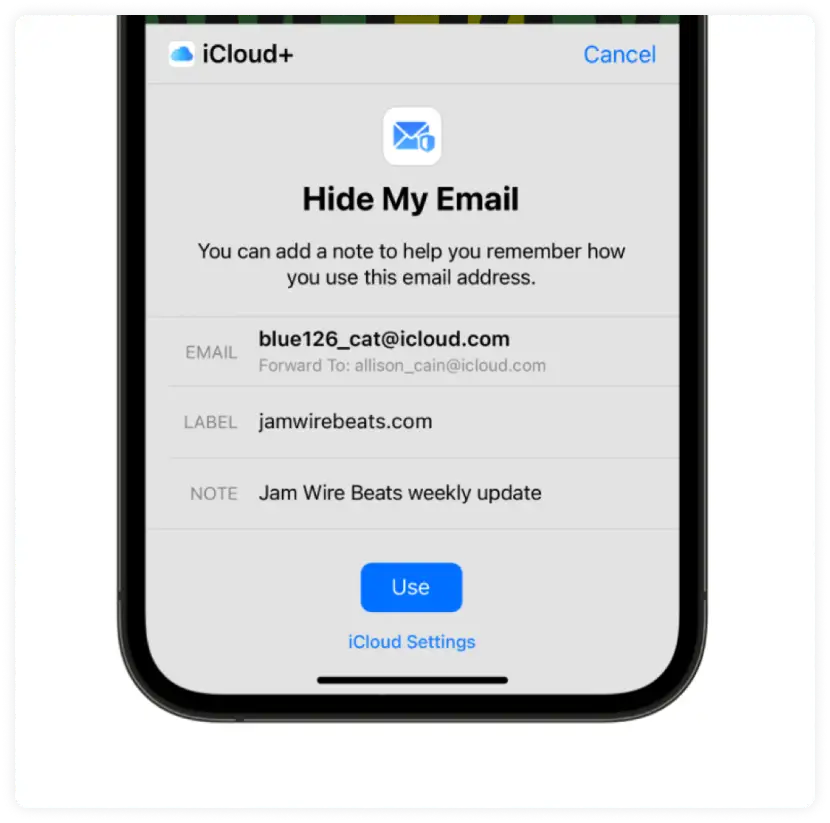In September 2021, Apple released iOS15 and iPad15. There were many new features in that version, one of the most talked-about among email markets was Apple MPP.
But, there was another feature that was launched which is Hide My Email.
So, what is it and will it affect email marketers? That’s what we will be answering in this guide.
Table of contents
What is Apple’s Hide My Email feature?
Apple’s Hide My Email is a paid feature that allows users to create a unique, random icloud.com email address that they can use to sign up for newsletters, fill out surveys, and much more. That email address will be unique to the app or website for which users created it.
Furthermore, each email sent to this email address will be forwarded to the email address chosen by the users.
When a user clicks on the email field Apple offers them an option to use their real email address or hide it. If the users choose the latter one, Apple creates a unique iCloud email address.

Any email sent to these relay addresses will automatically get forwarded to the email account chosen by the user.
Now, why should marketers be concerned about it?
First, users can turn off or delete these relay addresses at any time and any email sent to these ids afterward will result in a hard bounce.
But, that is not it.
If users are giving you a fake email address then this might have many impacts on your email campaign performance.
How will Hide My Email may affect email marketers?
There are two major impacts of this features:
1. Difficult to track user’s activity
You won’t be able to track users' activities as the address might not match with your first-party or even third-party data. It means you can't track who the person is, where they are coming from, etc.
Now, if you can't track users' activities and behavior then it will become difficult to map their journey and build their personas. As a result, you can face the following issues:
Unable to send relevant and targeted emails using segmentation and personalization.
Difficult to nurture new leads and build stronger relationships
Follow-up efforts can’t be done in the right manner.
2. Potentially hurt your email deliverability
Users can delete or turn off these relay email addresses anytime and if you have a lot of these in your email list then what will happen?
You guessed it, It will be a hard bounce.
And if the hard bounce exceeds 2% every month, then your future email can land in the user’s spam folder affecting your email deliverability. then it can hurt your email deliverability to Apple’s inbox.
Besides, there is no evidence that Apple isn’t going to ignore hard bounces caused by Hide My Email users.
Should you worry about Hide My Email feature?
Not really.
Let’s look at what experts are saying:
“I don’t see this having any larger of an impact than it already does through other similar services. This has always been a reflection of the level of trust the recipient has with your business or org. If someone is giving you a disposable address or their junk mail address, do they want to engage with you? Are they worth keeping on your list?”
Matt Dionne, Principal Template Engineer at Constant Contact
“I expect that most users of Hide My Email will be when users don’t trust the org they’re giving the email address to, to not use it outside the scope it was provided for. So, how much you need to be concerned will depend on how you gather and use email addresses.”
Steve Atkins, Owner at Word to the Wise
Actions that you can take to deal with Hide My Email address
Even though Hide My Email feature might not be adopted widely, it still has the potential to hurt your email campaign performance. To deal with this, we recommend you consider the following strategies:
If your hard bounce rate is more than 2% every month since 20 September 2021, then you should check and analyze the signup from the iCloud email addresses. As Apple uses the iCloud email address for both standards and hides my email feature, you should strategically look for any pattern that might be negatively affecting your email deliverability.
Be transparent with your old and new subscribers and make it easy for them to know and read how you use their information and what value will you offer them in exchange for that.
Conclusion
As the trust between organization and user has been broken too many times, organizations must take serious steps to protect users’ privacy by maintaining transparency and making users feel like they are not exploited.
Hide My Email is just a way that allows users to safeguard their identity against those whom they don't trust. So, if your customers trust you and you follow all the best practices then you don't have to worry about it at all.


